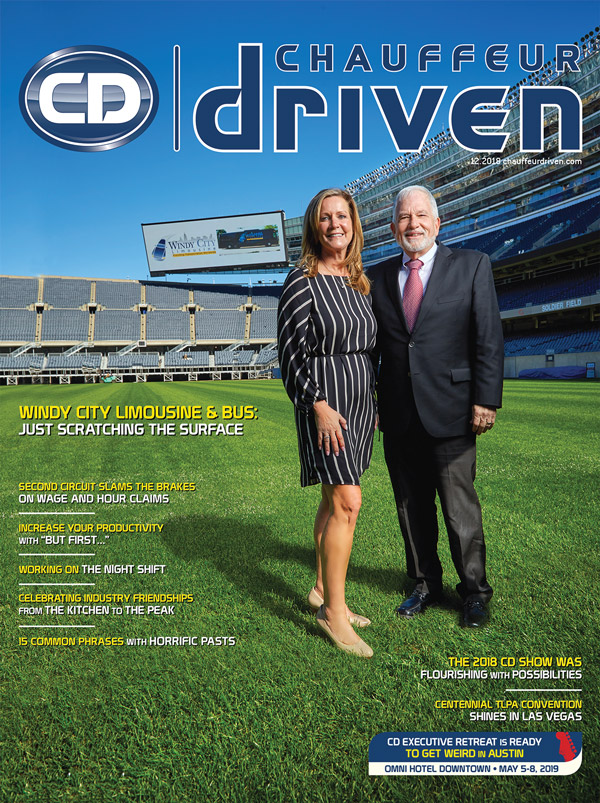 Cover Art: Windy City Limousine & Bus President Kathy Kahne and CEO George Jacobs on Soldier Field, with their logo on the scoreboard behind them. Photography by Bryan Chris.
February is typically one of the slowest months for Windy City Limousine & Bus. If you’ve ever been to Chicago in the winter, you’d understand why: It’s bitterly cold and often snowy, and residents and visitors alike are counting the days until the big thaw. But, in early 2018, the management at Windy City wasn’t ready for the dipping mercury to continue to freeze their profits this year, so they decided to take their buses on the road to the Super Bowl—albeit to the equally glacial Minneapolis.
Cover Art: Windy City Limousine & Bus President Kathy Kahne and CEO George Jacobs on Soldier Field, with their logo on the scoreboard behind them. Photography by Bryan Chris.
February is typically one of the slowest months for Windy City Limousine & Bus. If you’ve ever been to Chicago in the winter, you’d understand why: It’s bitterly cold and often snowy, and residents and visitors alike are counting the days until the big thaw. But, in early 2018, the management at Windy City wasn’t ready for the dipping mercury to continue to freeze their profits this year, so they decided to take their buses on the road to the Super Bowl—albeit to the equally glacial Minneapolis.
“The biggest event of the year for us was the Super Bowl. We decided to just do it: We sent 100 vehicles up there and reserved hundreds of rooms, had over 25 support staff, and more than 100 chauffeurs on the ground. It was the biggest booking event we’ve ever done and the biggest profit-maker we’ve ever had,” says CEO George Jacobs.
That’s why it was a no-brainer that Windy City would once again have a significant presence at the Super Bowl in 2019—despite the additional 300 miles it takes to get to Atlanta.
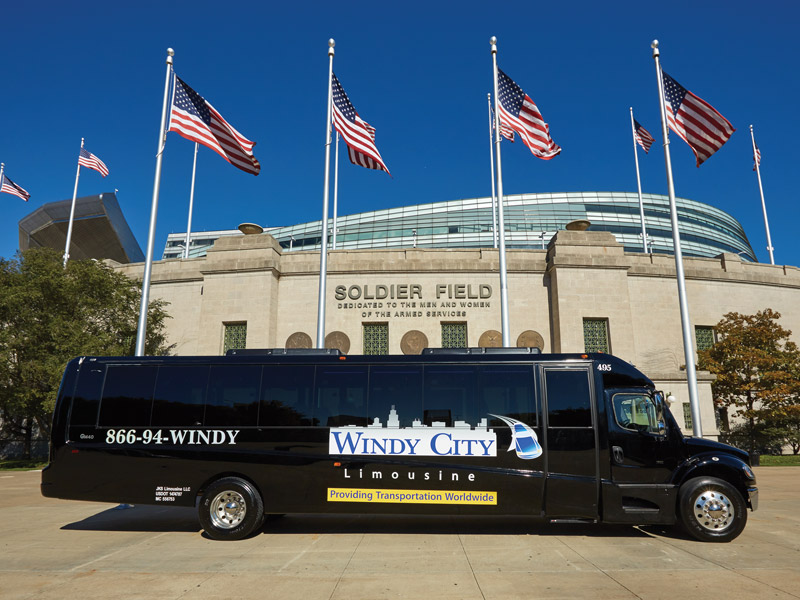 Chicago’s Soldier Field is a common destination for Windy City Limousine & Bus
“We have 1,000 room nights reserved in Atlanta and many contracts so far,” says Jacobs. “It is a little less bus-heavy than Minneapolis was, since they can walk to the stadium and the weather will be better, but the amount of cars, SUVs, and minibuses is crazy. Atlanta will be fun!”
Chicago’s Soldier Field is a common destination for Windy City Limousine & Bus
“We have 1,000 room nights reserved in Atlanta and many contracts so far,” says Jacobs. “It is a little less bus-heavy than Minneapolis was, since they can walk to the stadium and the weather will be better, but the amount of cars, SUVs, and minibuses is crazy. Atlanta will be fun!”
Marked growth has been on the agenda for Windy City with group work playing a major role. Jacobs says that they landed their biggest account ever this year after McDonald’s corporate moved to downtown Chicago, with other deals in the works.
“We’re expanding more and more into sports markets all over the country—the Final Four, we had 70 vehicles covering the Tiger Woods-Phil Mickelson match, plus the sponsors for the Super Bowl. It’s a huge amount of sports-related events: We handle all the teams and colleges in Chicago, and we picked up a ton of colleges nationwide. We’ve increased our farm-outs by probably at least five times in the past year and a half. We’re just growing and growing,” says Jacobs.
This type of aggressive and rapid expansion hasn’t been by accident. Windy City has steadily become the go-to transportation provider for all things sports in Chicagoland. Jacobs, a diehard sports fan, has captured the market from college sports to the professional leagues.
“I don’t know if I could name a team we don’t handle!” he says. “We transport the Cubs, the White Sox, the Bulls, the Bears, Northwestern University, the University of Chicago, Lewis University, Dominican University, Notre Dame ... so many to name. We do work for all the NCAA championships and Major League Baseball, too.”
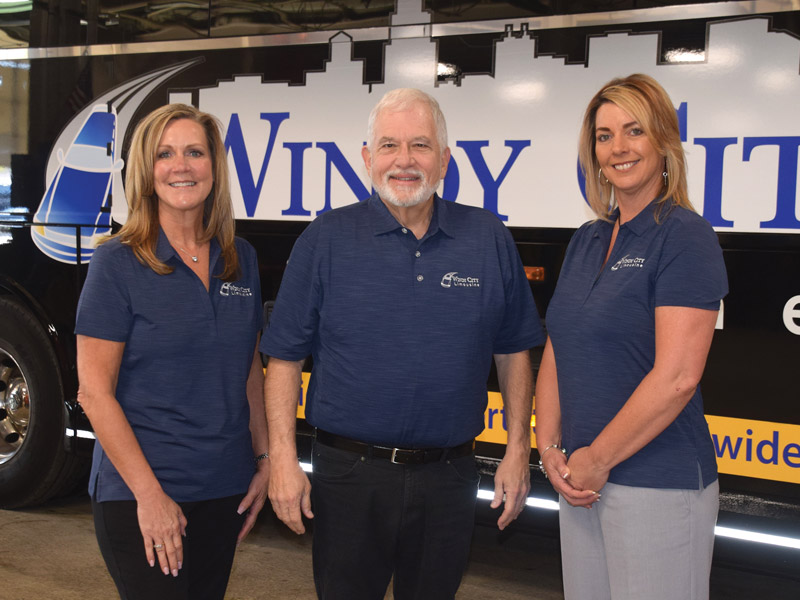 L to R: President Kathy Kahne, CEO George Jacobs,
and Executive Vice President Tracy Raimer
He says that he was a sports fan growing up and it’s a huge part of his life, so it was only natural that it would play a major role in his business life as well. He’s been recognized nationally—if you can believe it—as the “M&M guy” for the bright yellow jacket he wears to all White Sox games, a tradition that started more than a decade ago.
L to R: President Kathy Kahne, CEO George Jacobs,
and Executive Vice President Tracy Raimer
He says that he was a sports fan growing up and it’s a huge part of his life, so it was only natural that it would play a major role in his business life as well. He’s been recognized nationally—if you can believe it—as the “M&M guy” for the bright yellow jacket he wears to all White Sox games, a tradition that started more than a decade ago.
“Baseball was my favorite growing up—it still is. I love both the Cubs and the Sox but when they play each other, I have to pull for the White Sox,” he says.
2018 was also the first full calendar year since Jacobs merged with Tracy Raimer’s companies, Your Private Limousine and Chicago’s Transportation Group. When the discussions started, her companies were Windy City’s largest Chicago affiliates. Raimer, a successful entrepreneur in her own right, was part of the merger and became Windy City’s executive vice president. It not only opened up her customers to a diverse fleet with myriad transportation options and an expansive staff to handle them, it gave Raimer an opportunity to explore how she could thrive in a bigger operation and leave her mark on a company that she respected.
“I’m grateful that George and Kathy [Kahne, president] have been completely open regarding my role,” says Raimer. “They have just allowed me to fit into the company and to use my strengths where I see best, which tend to lean toward becoming a conduit between the employees, the Windy City team, and upper management. They’ve been open to the feedback, and we’ve been making a few changes here and there. I think it’s been great for the company and the employees, and I’m looking forward to what this collaboration is going to mean for Windy City in the future.”
“In my business’ history, I have discovered that there is so much I can learn from other people, and especially people who have smaller companies because they have a different mentality, they’re more hands-on, and I think we lose track of some of that when we’re as big as we are,” says Jacobs. “So it’s really refreshing for us—for me, in particular. We were a little stale and we weren’t hearing everything that was going on; now with Tracy here, she goes and addresses different departments, listens to what is working or not working, collaborates with each of the managers to improve efficiencies, or just brainstorms options to improve customer service or the culture to benefit the team as a whole. If they need building up, we build them up. If they need something physically done, we make it happen. The impetus is Tracy.”
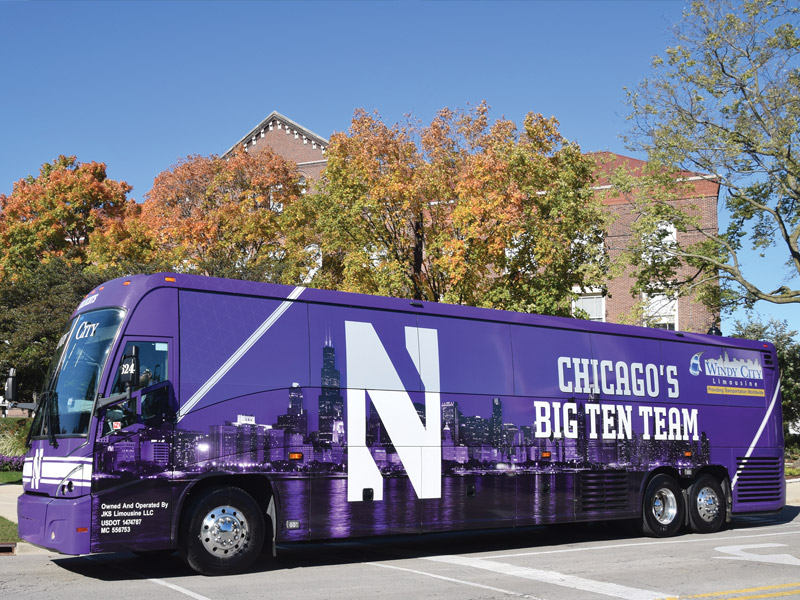 One of Windy City’s MCI motorcoaches bearing the Northwestern Wildcats branding
Jacobs and Raimer’s relationship dates back more than two decades when Raimer was at the helm of her one-car operation and looking for a mentor to help her navigate the complex Chicago rules. According to Jacobs, she approached him at a trade show in the ’90s and asked him for advice. He was flattered and impressed by the fire in her belly: He watched over the years as she became involved in the Illinois Limousine Association (ILA), was elected as its president, and oversaw its recent transition to the Illinois Limousine and Bus Association; he saw her companies grow and thrive; he admired her novel thinking when she started Chicago’s Transportation Group, which oversaw dispatching, payroll, and many other back-office functions for eight other companies while keeping them branded. He knew it would be difficult to convince her, but he broached the merger conversation anyway in 2017.
One of Windy City’s MCI motorcoaches bearing the Northwestern Wildcats branding
Jacobs and Raimer’s relationship dates back more than two decades when Raimer was at the helm of her one-car operation and looking for a mentor to help her navigate the complex Chicago rules. According to Jacobs, she approached him at a trade show in the ’90s and asked him for advice. He was flattered and impressed by the fire in her belly: He watched over the years as she became involved in the Illinois Limousine Association (ILA), was elected as its president, and oversaw its recent transition to the Illinois Limousine and Bus Association; he saw her companies grow and thrive; he admired her novel thinking when she started Chicago’s Transportation Group, which oversaw dispatching, payroll, and many other back-office functions for eight other companies while keeping them branded. He knew it would be difficult to convince her, but he broached the merger conversation anyway in 2017.
“I think when you’re merging with a large company, you fear that your culture will be lost or that you’re going to become just another cog in the wheel when you were once the boss. Tracy said to me, ‘Look, I run a company and I don’t want to become lost in the mix,’ and I promised her that she wouldn’t. The thing I wanted most was to have her look at all of our departments and enrich them—or make them even better. And she’s been just amazing at that. I kept that promise, and she’s a super valuable person in our company,” says Jacobs.
A large part of Raimer’s role has been as a staff liaison. She says that she meets frequently with department managers to listen to their needs and challenges, but also to just talk to them about their goals, to-do lists, and their suggestions. Jacobs says they’ve made some amazing changes already simply from ideas of various managers. Buy-in from the team has improved overall confidence and has led to the striking growth over the past year.
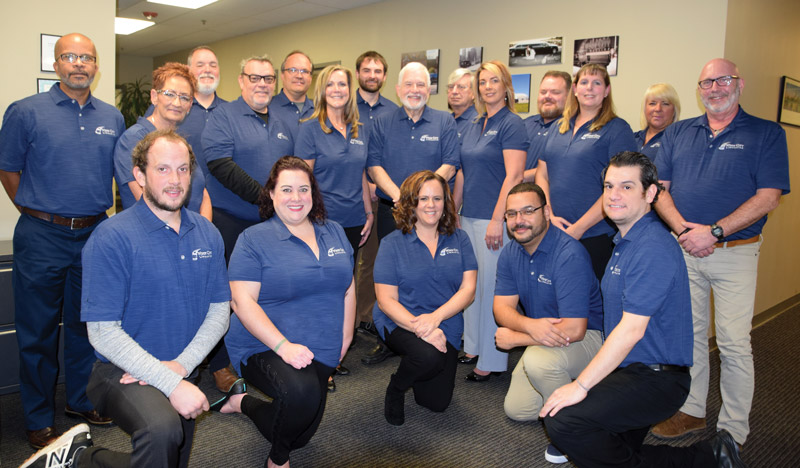 Windy City’s management team
“In fact, we’re having our first leadership retreat in January to bring the Leadership Team together,” says Raimer, which will include nearly 20 managers over the two-day event led by Jacobs and Kahne in Lake Geneva, Wisconsin. “They’re going to be providing HR training to help them in their positions—how to spot red flags when they’re hiring and interviewing, tips and best practices to utilize when they are training or coaching their team within each of their departments. They’re going to provide information on the methods used to create leaders versus just managing as well as learning the fundamentals on how money is spent once the revenue is generated. Our main goal is to be as transparent as possible, to let the Leadership Team know how critical they are to the success of the company, to ensure we are providing them all the tools and resources to be a successful leader and to encourage their collaboration to the future success of Windy City. George and Kathy are going to be sharing the vision of the company as well as the vision they have for themselves and how each of the managers fit into the future of the company. I think that’s something that the employees have always questioned but weren’t sure how to ask.”
Windy City’s management team
“In fact, we’re having our first leadership retreat in January to bring the Leadership Team together,” says Raimer, which will include nearly 20 managers over the two-day event led by Jacobs and Kahne in Lake Geneva, Wisconsin. “They’re going to be providing HR training to help them in their positions—how to spot red flags when they’re hiring and interviewing, tips and best practices to utilize when they are training or coaching their team within each of their departments. They’re going to provide information on the methods used to create leaders versus just managing as well as learning the fundamentals on how money is spent once the revenue is generated. Our main goal is to be as transparent as possible, to let the Leadership Team know how critical they are to the success of the company, to ensure we are providing them all the tools and resources to be a successful leader and to encourage their collaboration to the future success of Windy City. George and Kathy are going to be sharing the vision of the company as well as the vision they have for themselves and how each of the managers fit into the future of the company. I think that’s something that the employees have always questioned but weren’t sure how to ask.”
"Windy City is never afraid of new technology … really, it’s adapt or die." – George Jacobs, CEO of Windy City Limousine & BusJacobs says that the increase in large-scale events and groups as well as the big-name clients that they’ve contracted over the past year has increased staff enthusiasm.
“Oh, they love it,” says Jacobs. “You’d think Brian Heneghan, our chief dispatcher, owns the company by how much he cares. I tell everybody all the time to think like an owner, but it’s quite amazing the things that he does. He anticipates problems and solves them before they happen.”
“Don’t forget Dave Lahr, director of operations,” Raimer chimes in. “We’ll be sold out of buses, and all of a sudden someone says we need 15 motorcoaches. Dave makes it happen. I don’t know how he manages it when we’re already sold out, but often he does.”
“Dave is one of the original people who started with the company,” adds Jacobs. “His main function is to cover our bus work, and we often have more orders than we have buses and somehow he makes it happen. He’s a miracle worker!”
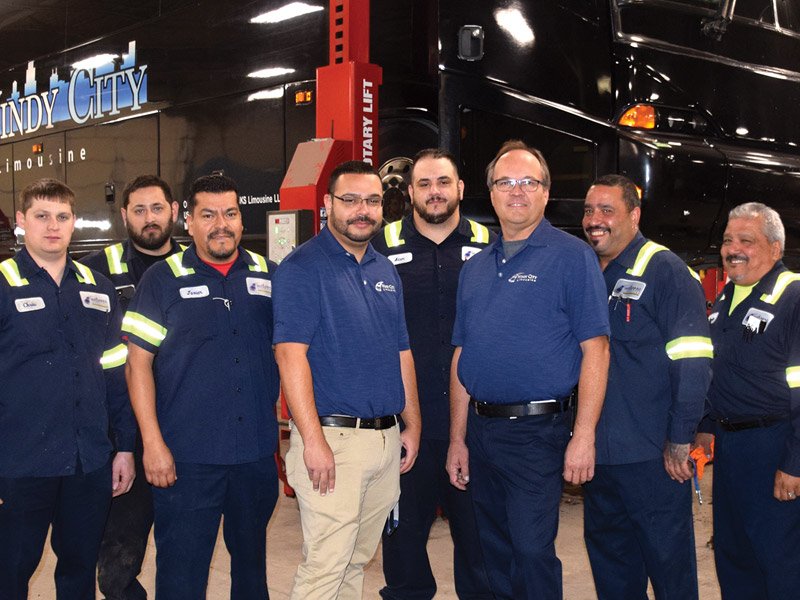 The crew that keeps the fleet running (L to R): Chris Osborne, Eduardo (Eddie) Sanchez, Javier Gonzalez, Fleet Manager Israel (Izzy) Cazares, Adam McLinn, Fleet Operations Manager Neil Rhebergen, Marcos Quintana, and Wash Crew Supervisor Charles Gonzalez
The enthusiasm and pride is evident outside the office, as well, as Windy City’s presence expands far beyond Chicagoland. Michael “A.J.” Jedrzejewski, the company’s chauffeur manager, set up a private Facebook page for chauffeurs and staff to post pictures of their current location or activity with Windy City vehicles—which could be Florida, Alabama, Kentucky, or anywhere else the job takes them. The hashtag #WindyCityisEverywhere shows an array of the exciting services that chauffeurs perform.
The crew that keeps the fleet running (L to R): Chris Osborne, Eduardo (Eddie) Sanchez, Javier Gonzalez, Fleet Manager Israel (Izzy) Cazares, Adam McLinn, Fleet Operations Manager Neil Rhebergen, Marcos Quintana, and Wash Crew Supervisor Charles Gonzalez
The enthusiasm and pride is evident outside the office, as well, as Windy City’s presence expands far beyond Chicagoland. Michael “A.J.” Jedrzejewski, the company’s chauffeur manager, set up a private Facebook page for chauffeurs and staff to post pictures of their current location or activity with Windy City vehicles—which could be Florida, Alabama, Kentucky, or anywhere else the job takes them. The hashtag #WindyCityisEverywhere shows an array of the exciting services that chauffeurs perform.
Recognizing that employee buy-in is an important key to consistent customer service, Jacobs says that management really tries to take care of their team. He says that they are continuously hiring and offering training, and because they want to attract and keep the best employees in the industry, the company offers them full benefits and a 401(k), which is matched. Windy City uses independent contractors—just like most of their competitors—but all in all, the company currently has a roster of over 150 employee-chauffeurs, more than any other company in Chicago, according to Jacobs.
“That’s what will bring Uber down,” says Jacobs. “Al Capone went to jail for tax evasion: Uber’s going to get busted for pretending that they don’t have employees.”
Technology has been another important area where Windy City has focused its resources—not just as a benefit to customers but as a standard for customer expectations. For affiliate work, Jacobs says that GNet (powered by GRiDD) has been a game-changer for efficiency between affiliate companies—for farm-out and farm-in. He’s also a major fan of Zipwhip, which allows their dispatchers to have multiple conversations going at a time via text rather than just one via a phone call, which reduces client frustration by being on hold or receiving a busy signal. They still have live agents answering the phone, but offering different and modern ways to connect with customers in their preferred method has been beneficial for everyone involved.
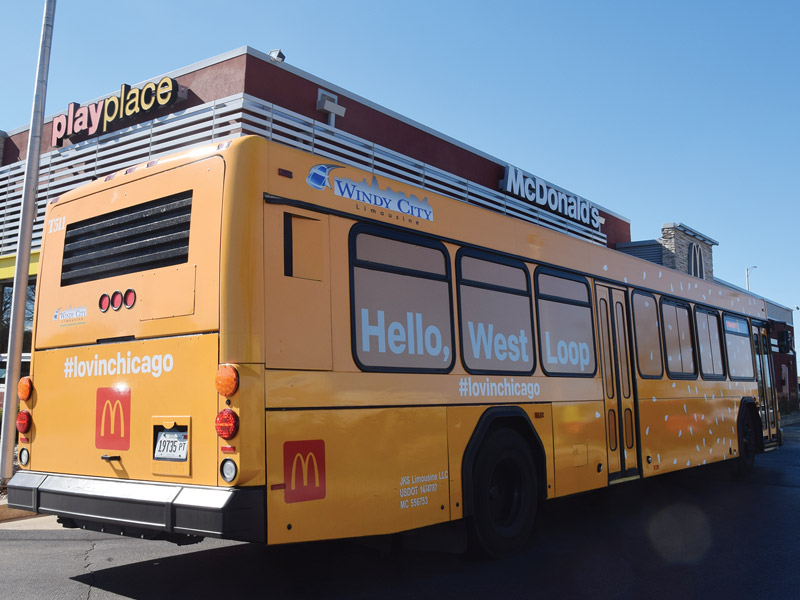 Windy City handles transportation for McDonald’s new Chicago HQ
“Windy City is never afraid of new technology,” says Jacobs. “We have push-to-chat talk on our website, so if you have questions, you can talk to an operator while you’re doing something else. We have automatic text messages that are sent when you land; we send greeter texts and use geofencing to text when the car is 10 minutes out. Customers don’t want chauffeurs to call anymore. We also bought part of a software company that created an app that we can give to our clients and it allows them to see every car at their disposal. It tells you the chauffeur name and number, ETA of every vehicle they’re using, which direction they’re heading, when they’re going to be there, and who they have on board—it’s amazing. Which also means no more excuses: Our chauffeurs darn well better be on time. Really, it’s adapt or die.”
Windy City handles transportation for McDonald’s new Chicago HQ
“Windy City is never afraid of new technology,” says Jacobs. “We have push-to-chat talk on our website, so if you have questions, you can talk to an operator while you’re doing something else. We have automatic text messages that are sent when you land; we send greeter texts and use geofencing to text when the car is 10 minutes out. Customers don’t want chauffeurs to call anymore. We also bought part of a software company that created an app that we can give to our clients and it allows them to see every car at their disposal. It tells you the chauffeur name and number, ETA of every vehicle they’re using, which direction they’re heading, when they’re going to be there, and who they have on board—it’s amazing. Which also means no more excuses: Our chauffeurs darn well better be on time. Really, it’s adapt or die.”
Technology also helped toward the easy transition when the companies were combining resources in 2017.
“Merging four companies was unbelievably smooth because we were all operating on The Hudson Group systems,” says Raimer. “I have to give accolades to Ryan Kaczmarski, our IT director, and the staff in our IT department for how effortless they made it seem and for customers to realize that we’re in a different office. I think because we operated so similarly, it made it easier.”
With the merger, a name change for Raimer’s companies was imminent to uphold transparency to our customers, so Windy City staff would answer a call with Raimer’s company name, followed by “powered by Windy City” during the changeover. Customers would then get used to the Windy City name and partnership, which would possibly lead to the opportunity for additional questions about the benefits of the merger.
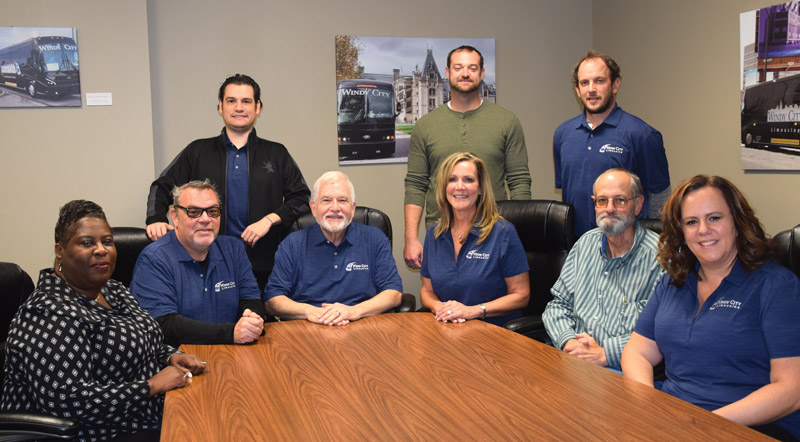 Standing (L to R): Fleet Manager Anthony Ugalde, Dispatch Manager Justin Wagner, and Director of Technology & Content Strategy Ryan Kaczmarski Seated (L to R): CSR LaVonne Hawkins, Director of Operations Dave Lahr, CEO George Jacobs, President Kathy Kahne, Bus Dispatch Supervisor Scott Wagner, and Accounting Manager Lisa Wilinski
“Of course you have your hiccups along the way; customers are used to the same people answering the phone,” she says. “We did have to go through those challenges and definitely communicate with our clients that there has been this transition. But we could also tell them more about the new services available to them. We could highlight their options.”
Standing (L to R): Fleet Manager Anthony Ugalde, Dispatch Manager Justin Wagner, and Director of Technology & Content Strategy Ryan Kaczmarski Seated (L to R): CSR LaVonne Hawkins, Director of Operations Dave Lahr, CEO George Jacobs, President Kathy Kahne, Bus Dispatch Supervisor Scott Wagner, and Accounting Manager Lisa Wilinski
“Of course you have your hiccups along the way; customers are used to the same people answering the phone,” she says. “We did have to go through those challenges and definitely communicate with our clients that there has been this transition. But we could also tell them more about the new services available to them. We could highlight their options.”
Although Jacobs and Raimer would pass work to each other before the merger, one area that gave Raimer pause was bus work. Like most companies, Windy City’s buses are prominently marked with the company name, and Raimer was concerned that her clients would instead work directly with the farm-out company in the future. The merger, however, opened up the possibilities for her longtime clients to book buses—and helped her land a few accounts in the process.
Raimer and Jacobs credit IT Manager Ryan Kaczmarski with both the easy transition during the merger and in adopting new technological platforms to stay competitive, proficient, and ahead of the curve. Like so many others, Kaczmarski moved through the ranks as Jacobs saw his potential.
“We used to bury Ryan in work, but now the more he has, the more he comes up with on his own to make things better,” says Jacobs. “He’s constantly finding things that we can do that will make us more efficient, smarter, and better. He’s always thinking from both the customer’s and employee’s perspectives—but also from a cost-saving perspective as well. He was our first employee, and he just became something really special to the company.”
One of the benefits of having dedicated departments handle the minutiae that once fell on Raimer’s shoulders as a small company owner is a newfound freedom to take on new tasks and tackle different issues. It was, in fact, a point that Jacobs used to sell her on the merger—and it’s clear that he has serious respect for her.
 A Windy City bus at legendary Wrigley Field
“She’s very knowledgeable and intuitive about how things should be done and what could make it better, and she’s doing that for Windy City,” says Jacobs. “I knew of her great work with the ILA. I encouraged her to run for the NLA board, and I think she’s successful on it. She has the opportunity to do so many more things now, so she can expand her horizons. We have her expertise and we’re putting her potential to full use because she’s not bogged down with all the things she had to do when operating her own company.” Raimer is also a longtime member of Chauffeur Driven’s Advisory Board.
A Windy City bus at legendary Wrigley Field
“She’s very knowledgeable and intuitive about how things should be done and what could make it better, and she’s doing that for Windy City,” says Jacobs. “I knew of her great work with the ILA. I encouraged her to run for the NLA board, and I think she’s successful on it. She has the opportunity to do so many more things now, so she can expand her horizons. We have her expertise and we’re putting her potential to full use because she’s not bogged down with all the things she had to do when operating her own company.” Raimer is also a longtime member of Chauffeur Driven’s Advisory Board.
Raimer agrees: “Coming from a smaller company, one of the first things I said to George and Kathy was—and I still feel it today—I believe that Windy City is just scratching the surface. I think there’s so much opportunity and potential for Windy City because of the great team that George skillfully created.”
"Merging four companies was unbelievably smooth … I think because we operated so similarly, it made it easier." – Tracy Raimer, Executive Vice President of Windy City Limousine & BusThere have been speedbumps and times of frustration for Raimer as she acclimated to her new role, although she says that the sweet has far outweighed the bitter. It’s easier and faster to effect change in a smaller company because of its size and level of complexity compared to bigger operations—especially for an owner entrenched in so many of the processes. Smaller companies are more nimble.
“I would have to say the only major challenge that has taken me—it’s still taking me a bit to get used to—is the process to implement change. Because of the company’s size, it’s very difficult to just implement a new idea,” she says. “I love the fact that George and Kathy aren’t micromanagers, which allows managers to just be open and do what they’re good at. Our team has the passion, the commitment, the dedication, and without a doubt, the knowledge and expertise to get the job done. It’s really cool to be in the office and watch the amount and the type of work they do without thinking twice about it.”
Jacobs is a self-professed student of the industry, in that he is always learning from his colleagues and friends as much as he is offering his own advice to those who seek it. He feels that a good idea is simply a good idea, no matter where it comes from.
“Even after 35 years in the industry, I keep learning things, so giving back is just like second nature,” he says. “I love helping people get better, to grow. I look forward to the CD Mentoring Program every year at the show; I can’t wait to do it. You want others to become better because the better they are, the more they’ll challenge you and make you better. If you look at all the big companies, we didn’t do this all ourselves. Everything I have in my life I got from this industry, and it would be a crime if we all didn’t give back and share in some way or another. We have to encourage others when they’re down—and encourage them when they’re up to make them more successful. You’re creating allies, not competition. Mentoring is just in my blood—I love it.”
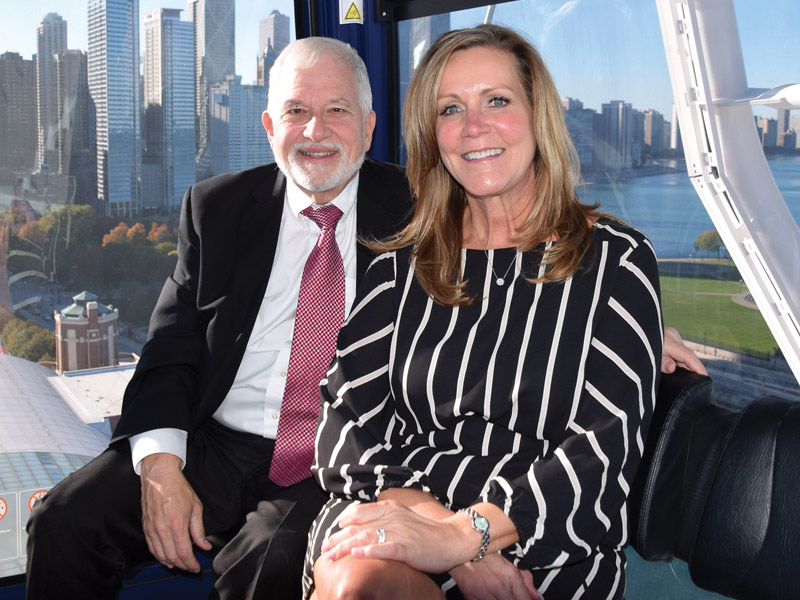 Windy City CEO George Jacobs and President Kathy Kahne with a view from the Navy Pier Ferris Wheel
Raimer also harkens back on her early years when she received a guiding hand from people like Jacobs and members of the ILA. As the association’s president, she has become a mentor herself, fighting hard for the entire industry in the Chicago area.
Windy City CEO George Jacobs and President Kathy Kahne with a view from the Navy Pier Ferris Wheel
Raimer also harkens back on her early years when she received a guiding hand from people like Jacobs and members of the ILA. As the association’s president, she has become a mentor herself, fighting hard for the entire industry in the Chicago area.
“Right from the beginning, I just saw that others in the industry were so giving, which is just that easy to do. It’s easy to receive satisfaction from helping others and watching them grow,” she says. “I feel like that’s what it’s all about—whether you’re observing employees in your own company grow and achieve their personal visions in their own life because of their work, or watching other operators grow from one to five to 10 cars just because you’re able to help them along the way. I’m not sure if I would have stayed in the industry had I not had that help at that time.”
Momentum is the name of the game as Windy City enters the New Year. Jacobs anticipates keeping the company on its current course.
“We are going to continue to grow in 2019, that’s all we know how to do. But we focus on customer service. We add million-dollar accounts all the time, but we don’t outkick our coverage: We make sure that we have the ability to grow internally, technologically, and human-wise, and that we’re able to handle the business we bring in. There’s no sense in bringing in work if you can’t handle it. It’s our goal to make sure that we’re able to handle our growth in a professional, upscale manner. We want to keep people happy. We want to keep our old clients happy and make our new clients ecstatic that they’ve moved over.” [CD1218]

